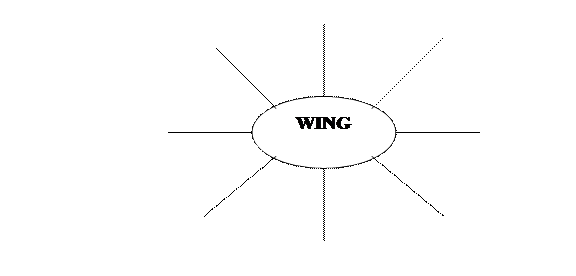Choose the best alternative to fill the gaps in these sentences
1. The aircraft rises into the air and keeps there because of ______.
a) wind b) light weight c) forces working on it
2. The air traveling across the top of the wing creates a _______ on the upper surface.
a) increased pressure b) reduced pressure c) reduced lift
3. Aircraft high speed is produced by a _______ that acts in the direction of airplane’s motion.
a) force of thrust b) wing c) flight controls
4. _____ and _____ are artificially created forces.
a) lift, drag b) thrust, lift c) thrust, gravity
5) The engine-propeller combination is designed ______ .
a) to create lift b) to overcome drag c) to decrease weight
Focus on Writing
Translate the text in a written form.
High-Speed Flight Ranges
Transonic. When the speed of flight is less than the speed of sound, but of sufficient velocity to induce supersonic airflow over some part of the structure of the aircraft, the airplane is said to be in the transonic speed range. That is, it is in the region of speed of sound; exactly at the speed of sound the aircraft would be described as being at sonic speed.
Supersonic.As flight speed increases further, a point is reached where the airflow over all parts of the aircraft is supersonic, or above the speed of sound. When this happens, the airplane is in the supersonic speed range.
Hypersonic.As a body moves through the air at high speeds, a short amount of time is required for the molecules of air to adjust themselves to the presence of the fast-moving body and to readjust themselves after the body has passed through them. This period of adjustment and readjustment is called the relaxation time. If a body is moving at a speed greater that the relaxation time, it can be classed as being in the hypersonic speed range.
UNIT 8
Wing
Preparing to Read
Brainstorm all possible terms related to the topic.

Before you read the text name the main functions of the wing, try to describe wing structure. Share your ideas with your group mates.
Reading
Read the text and write a brief heading for each paragraph.
Read the text and write out the underlined words. Try to guess their meaning from the context. Compare your notes with your partners.
Wing
A. The main lifting surfaces of every airplane are wings. The wings are light structures which extend out on each side of the body. Their function is to push downward on the air as the machine moves through it. This push or lift of the wings is the secret of the support of the airplane in the air.
B. The wing is divided into three sections: a wing root, an inter-mediate section and a wing tip. The front edge of the wing is called the leading edge and the rear one is called the trailing edge. There are some movable parts on the trailing edge of the wing. These are ailerons, flaps and trimmer tabs.
C. The primary function of the wing is to produce lift (lifting force) for flying. The secondary function is to house many vital parts of the aircraft, such as fuel tanks, control mechanism and very often the engines and landing gear bay are arranged in the wing structure.
D. The distance from the wing tip on one side to the wing tip on the other side is called the span and the distance from the leading edge of the wing to the trailing edge is the chord.
E. The shape of the wing is of great importance for an aircraft. There are different configurations of the wing. There are rectangular and elliptical wings, wings of trapezoidal form, straight, sweptback and sweptforward wings. There is also a delta wing form.
F. The wing structure consists of longitudinal structural members - spars, stringers and beams and of transverse elements — ribs. The wing structure is covered with skin (or covering). According to the position in which the wing of a monoplane is fixed in relation to the fuselage the aircraft is called a low-wing monoplane, a mid-wing monoplane and a high-wing monoplane.
G. The aerodynamic loads on the wing produce bending, shear and torsion. A typical construction of a wing must resist these loads and usually consists of a thin sheet metal shell of airfoil shape, reinforced within by spanwise stiffeners and transverse ribs. Every component of an airplane must be so designed that it could carry its intended function.
H. Light weight is very important in an airplane structure because every pound of structural weight replaces a pound of payload. The wing structure is no exception in this respect. The stressed skin type of construction was adopted because it can be made light.
Comprehension Check
